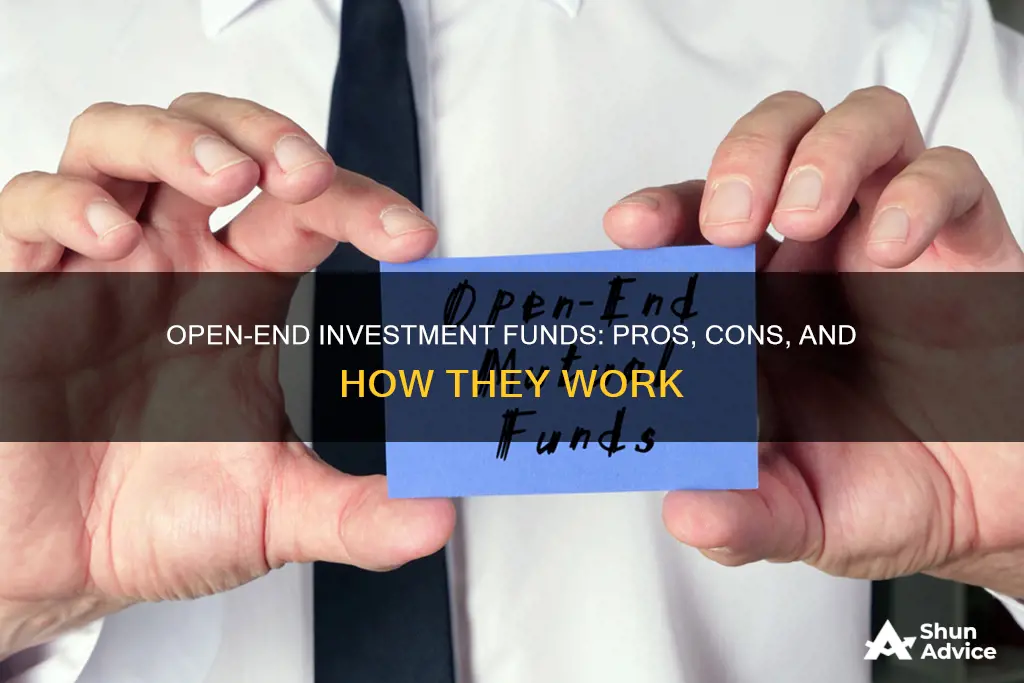
Open-end funds are a type of collective investment scheme that can issue and redeem shares at any time. They are called open-end because they do not have a fixed number of shares and can accommodate an unlimited number of investors. These funds are typically actively managed by a portfolio manager and are priced according to their net asset value (NAV). Most mutual funds and exchange-traded funds (ETFs) fall under this category. Open-end funds are a popular choice for investors seeking diversification and flexibility, allowing them to enter and exit investments as per their convenience.
What You'll Learn

Open-end funds are a type of collective investment scheme
Open-end funds are available in most developed countries, including the US, the UK, and Europe. They are actively managed, meaning that a portfolio manager picks the securities to buy. However, index funds, which replicate an index and do not allow the manager to actively choose securities, are growing in popularity.
Open-end funds do not have a fixed number of shares and can be traded at times dictated by fund managers during the day. Shares are issued as long as there is demand for the fund. When investors buy new shares, the fund company creates new, replacement ones.
Prices for open-end funds are fixed once a day at their NAV and reflect the fund's performance. The price per share, or NAV, is calculated by dividing the fund's assets minus liabilities by the number of shares outstanding. This is usually calculated at the end of each trading day.
Some open-end funds may charge investors a fee when shares are purchased or sold. A front-end load is a fee or commission charged when an investor initially purchases shares, while a back-end load is charged when investors sell shares. Other open-end funds do not charge any fees at all and are known as no-load funds.
SBI Mutual Fund Investment: Your Guide to Getting Started
You may want to see also

They can issue and redeem shares at any time
Open-end funds are a type of collective investment scheme that can issue and redeem shares at any time. This means that investors can buy and sell shares in the fund on a continuous basis, entering and exiting as they please. This is in contrast to closed-end funds, which typically issue a fixed number of shares at the outset, and these are then traded among investors.
Open-end funds do not have a limit on the number of shares they can issue. When investors buy new shares, the fund company creates new, replacement ones. Likewise, when investors sell shares, the fund company takes them out of circulation. This means that the number of outstanding units in an open-end fund can fluctuate over time, depending on whether the fund is selling or repurchasing more units.
The price at which shares in an open-end fund are issued or can be redeemed will vary in proportion to the net asset value (NAV) of the fund. The NAV is calculated by subtracting the fund's liabilities from its assets and then dividing this figure by the number of outstanding shares. This is usually calculated at the end of each trading day, and the fund's shares are priced at this value.
Open-end funds are available in most developed countries, including the US, the UK, and Europe, and are a popular choice for investors due to their flexibility and diversification benefits.
Healthcare Funds: Smart Investment or Risky Business?
You may want to see also

They are available in most developed countries
Open-end funds are available in most developed countries, but the terminology and operating rules vary. For example, in the US, they are known as mutual funds, whereas in the UK they are called unit trusts and OEICs, and in Europe, they are known as SICAVs. Hedge funds are also a type of open-ended fund.
Open-end funds are a collective investment scheme that can issue and redeem shares at any time. An investor will generally purchase shares in the fund directly from the fund itself, rather than from existing shareholders. This is in contrast to closed-end funds, which typically issue all their shares at the outset, and these are then traded among investors.
The price of shares in an open-ended fund is calculated by dividing the fund's assets minus liabilities by the number of shares outstanding, also known as the net asset value (NAV). This is usually calculated at the end of every trading day. The price of shares will vary in proportion to the NAV of the fund and so directly reflects its performance.
Open-end funds are actively managed, meaning a portfolio manager picks the securities to buy. However, index funds are growing in popularity. These are open-end funds that attempt to replicate an index, such as the S&P 500, and do not allow the manager to actively choose securities to buy.
A Guide to Investing in Canadian Mutual Funds
You may want to see also

They are actively managed by a portfolio manager
Open-end funds are a type of collective investment scheme that can issue and redeem shares at any time. They are often compared with closed-end funds, which issue a fixed number of shares at the outset, and these are then traded among investors. Open-end funds, on the other hand, do not have a limit on the number of shares they can issue. They are actively managed by a portfolio manager, who picks the securities to buy. This manager must continually adjust holdings to meet investor demand.
Open-end funds are available in most developed countries, including the US, the UK, and Europe. They are also more common than closed-end funds and are the primary investment option in company-sponsored retirement plans, such as 401(k) plans. Most mutual funds and exchange-traded funds (ETFs) are open-end funds.
The price of shares in an open-end fund is calculated by subtracting the fund's liabilities from its assets and then dividing that figure by the number of shares outstanding. This is usually done at the end of each trading day and is called the net asset value (NAV). Shares are bought and sold on demand at their NAV.
As open-end funds are actively managed, they can have higher fees than other funds. These fees are typically charged when shares are purchased or sold, and they may be a one-time charge or a percentage of the value of the shares. These fees can cover the cost of distributing the fund, such as paying a commission to the adviser or broker. However, not all open-end funds charge fees, and those that don't are known as "no-load" funds.
Open-end funds provide investors with a low-cost, flexible way to pool money and buy a diversified portfolio. They allow investors to enter and exit as they please and do not require a large amount of money to gain entry.
MER Investment Funds: What's the Deal?
You may want to see also

They are priced in relation to the Net Asset Value (NAV)
Open-end funds are priced in relation to their Net Asset Value (NAV). The NAV is the value of an investment fund, determined by subtracting its liabilities from its assets. The per-share NAV is calculated by dividing the NAV by the number of shares outstanding.
The price per share, or NAV, is calculated by dividing the fund's assets minus liabilities by the number of shares outstanding. This is usually calculated at the end of every trading day. The NAV per share is the price at which new investors buy shares in the fund.
The NAV is calculated only at the close of trading each day for open-end mutual funds. The daily basis of the net asset value is on the value of the fund's underlying securities. The fund's per-share NAV is then obtained by dividing NAV by the number of shares outstanding.
Open-end funds are priced at their NAV at the end of each day, reflecting the fund's performance. This value is the fund's assets minus its liabilities. This is the only price at which fund shares can be purchased that day.
The share price paid for an open-end mutual fund – the net asset value per share – is the per-share price that new investors pay for a share in the mutual fund.
Invest Wisely: High-Return Funds for Smart Investors
You may want to see also
Frequently asked questions
An open-end fund is a collective investment scheme that can issue and redeem shares at any time. It is a diversified portfolio of pooled investor money that can issue an unlimited number of shares.
An open-end fund issues shares if buyers want them. It's always open to investment. When investors buy new shares, the fund company creates new, replacement ones.
A closed-end fund has a fixed number of shares issued by the fund, while an open-end fund does not have a limit on the number of issued shares.
Mutual funds, hedge funds, and ETFs are all examples of open-end funds.







